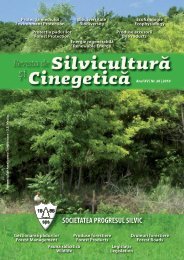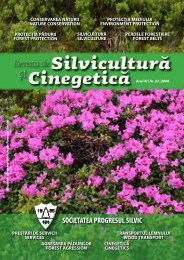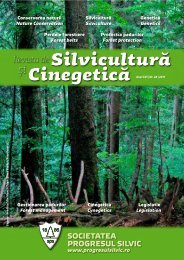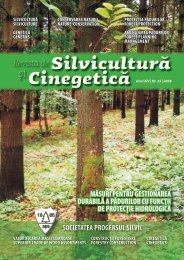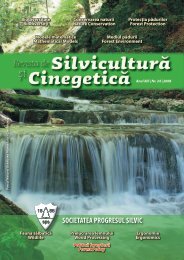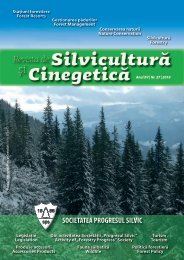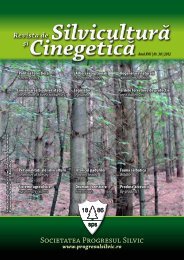Silviculture and Cinegetics Review - Societatea Progresul Silvic
Silviculture and Cinegetics Review - Societatea Progresul Silvic
Silviculture and Cinegetics Review - Societatea Progresul Silvic
You also want an ePaper? Increase the reach of your titles
YUMPU automatically turns print PDFs into web optimized ePapers that Google loves.
FORESTRY BELTS SILVICULTURE AND CINEGETICS REVIEW XVII/30/2012<br />
dem<strong>and</strong>ing to the edaphic conditions, it grows well on<br />
dry, shallow soils with high content of calcium<br />
carbonate; it shows resistance to drought <strong>and</strong> frost. It<br />
needs intensive summer heat. Growth is active in youth,<br />
at 5 years achieving heights of 2-3 m, but weakens with<br />
age. It has tap-spreading roots, with long lateral<br />
branches, deeply rooted, that are deeper <strong>and</strong> richer than<br />
the cherry’s. It sprouts <strong>and</strong> suckers weakly. Its use is<br />
recommended mainly in the case of shallow, coarse<br />
soils, with high content of calcium carbonate, in the<br />
marginal <strong>and</strong> post marginal rows of the field <strong>and</strong> road<br />
protection belts.<br />
White mulberry (Morus alba) was used in the railway<br />
protection belts (Brăila <strong>and</strong> Galalţi counties), intimately<br />
mixed with shrubs <strong>and</strong> tree species; it has a medium<br />
open temperament. Being resistant to drought <strong>and</strong><br />
winter frosts, it sometimes suffers because of the early<br />
frosts. It shows modest to edaphic conditions, growing<br />
even on compressed soils, having good results<br />
especially on cambic, argillic chernozems <strong>and</strong> alluvial<br />
soils. Mulberry resists rather well to insects <strong>and</strong> very<br />
well on fungi attacks. Growth is slow in the first year,<br />
then very active, at age 5 years achieving height of 2-3<br />
m, <strong>and</strong> its longevity is of approx. 150 years. It has tapspreading<br />
roots; it sprouts weakly. It reacts well to<br />
pruning, so it can be used to form hedges. It may be<br />
used in the steppe <strong>and</strong> forest steppe, in the central part<br />
of the field <strong>and</strong> communication protection belts.<br />
Osage-orange (Maclura aurantiaca), although this is<br />
an exotic species, was frequently used in the railway<br />
belts installed during 1950-1960, mainly in the marginal<br />
<strong>and</strong> post marginal rows, having a mid-shade<br />
temperament. Resistant to drought, it develops well on<br />
fertile soils, but it also led to good results on alluvial<br />
soils (Photo 9). It sprouts abundantly <strong>and</strong> it suckers<br />
well. It shows a dense crown, with rich foliage, which is<br />
particularly important to its use in the snow protection<br />
forest belts. Growth is quite rapid. It has deep, richly<br />
branched roots, being an option for the border of<br />
communication protection belts.<br />
Oleaster (Elaegnus angustifolia) was used mainly in<br />
the field <strong>and</strong> anti-erosion belts, in the marginal rows,<br />
having an open temperament. It has a large ecological<br />
amplitude <strong>and</strong> grows quite actively even on salty soils,<br />
but the best on more humid soils. It shows a great<br />
resistance to frost, but prefers a climate with warm<br />
summers.<br />
Its particular rusticity confers its quality of species<br />
recommended to hard situations of installation of forest<br />
vegetation, with poor soils (alluvial protosols <strong>and</strong> salty,<br />
but not too dry soils).<br />
Under favorable vegetative conditions, growth is very<br />
active (it reaches 2-3 m height three years after<br />
plantation - Vulturu-Vrancea experimental block). It has<br />
spreading roots; it sprouts <strong>and</strong> suckers.<br />
Research has shown that its introduction in black locust<br />
based field protection forest belts, in the outer rows, on<br />
chernozem soils, had poor results. Due to its strong<br />
open temperament <strong>and</strong> active growth, on the northern<br />
side of the forest belts, searching for light, oleaster<br />
developed asymmetrically (baggy), towards the exterior<br />
of the forest belt.<br />
Under the aforementioned conditions, in winters with<br />
abundant precipitation, snow crown accumulation has<br />
produced serious sharp bending <strong>and</strong> breakage of trunk<br />
<strong>and</strong> branches.<br />
On the other h<strong>and</strong>, its thin <strong>and</strong> flabby crown ensures a<br />
weak contribution to density regulation (i.e. to create a<br />
reduced penetration in the road protection belts), <strong>and</strong><br />
hinders the development of tree species in the<br />
immediate vicinity. Better results were obtained by<br />
using osage-orange or honey locust in similar site<br />
conditions.<br />
With all the disadvantages mentioned, oleaster is<br />
recommended for use in all types of protection forest<br />
belts, in hard to extreme site conditions, on poor <strong>and</strong><br />
even salty soils, on marginal <strong>and</strong> post marginal rows,<br />
mixed with shrubs (Photo10).<br />
Common walnut (Juglans regia) was analyzed based<br />
on research on some alignments installed along the<br />
roads (Mărăşeşti, Focşani) <strong>and</strong> on field protection forest<br />
belts (Bărăganu Station) or roadside (Suraia).<br />
Planted on chernozem soils <strong>and</strong> deep coluvisoils,<br />
strongly humiferous, walnut shows a good vegetative<br />
state, growth being active. It has tap, strongly developed<br />
roots <strong>and</strong> sprouts quite vigorously.<br />
However it was noted that where planting distance<br />
between trees was less than 5-6 m, their crowns show an<br />
asymmetric development, branches do not overlap but<br />
derange each other <strong>and</strong> fructification is weak.<br />
Furthermore, the sanitary cuts made in the crown have<br />
not led to expected effects, emphasizing their<br />
asymmetry. Instead, trees located at 8-10 m have a<br />
much better crown <strong>and</strong> trunk conformation, <strong>and</strong> a good<br />
fructification, due to walnut pronounced open<br />
temperament.<br />
42



